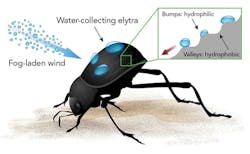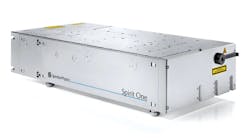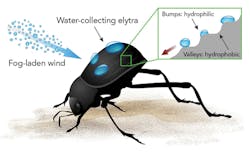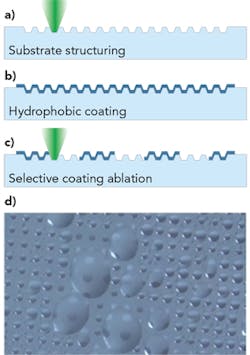Anti-fogging surfaces can be fabricated on glass surfaces using an ultrafast laser
VICTOR MATYLITSKY, MATTHIAS DOMKE, SANDRA STROJ, and KLAUS HARTINGER
The exciting functionalities of natural superhydrophobic and superhydrophilic surfaces—for example, the extreme water repellency of the lotus flower—served as inspiration for a variety of biomimetic (the imitation of biological systems to yield innovative and highly functional technologies) designs. It was demonstrated that both hydrophobic and hydrophilic surfaces can be fabricated by laser machining.
Recently, the research center for microtechnology at Vorarlberg University of Applied Sciences (Dornbirn, Austria), in collaboration with Spectra-Physics (Santa Clara, CA), developed the ClearSurface femtosecond laser-based process for fabrication of functional surfaces. This process, in combination with the industrial femtosecond Spirit lasers (FIGURE 1), allows fast and flexible fabrication of superhydrophilic and superhydrophobic surfaces. It also enables the application of these wetting properties to a variety of substrates and the resulting contact angle can be precisely controlled by adjusting the laser parameters.
FIGURE 1. Spectra-Physics’ Spirit One industrial femtosecond laser is shown.
In this article, an overview of possible applications for functional surfaces generated by femtosecond laser machining will be presented. In particular, application of the femtosecond laser machining for manufacturing of surfaces with enhanced fog-collection efficiency and the anti-fogging properties will be discussed.
Biomimetic fog-collecting surfaces
Water scarcity is one of the major global problems, affecting every continent and more than 700 million people.1 Interestingly, precipitation occurs in many arid regions mainly in the form of dew and fog,2 a circumstance to which the local flora and fauna have adapted by developing functional surfaces.3 The Darkling beetles (Tenebrionidae) are native to the Namib Desert, where the cold Benguela current runs across the coastline and regularly causes fog banks rolling over the dunes.4 To harvest water from fog, the beetle tilts its back towards the fog-laden wind,5 droplets attach to the hydrophilic bumps on its elytra, coalesce to large water drops until they are detached by gravity, and roll to the beetle’s mouth directed by the hydrophobic valleys (FIGURE 2).6, 7
FIGURE 2. Fog-collecting principle of the Namib Desert beetle; droplets from the fog-laden wind accumulate on the hydrophilic bumps until they reach a critical size and roll down the hydrophobic valleys towards the beetle’s mouth.
The goal of the study was to mimic the Namib Desert beetle’s elytra (one of the pair of hardened forewings of certain insects) by fabricating high-contrast wetting patterns on glasses and to evaluate their fog-collection efficiency. For this purpose, the ClearSurface process, which combines femtosecond laser micromachining and surface coating, was employed. The high-contrast wetting micropatterned surface was fabricated in three process steps (FIGURE 3).
FIGURE 3. Process steps to generate surfaces with mixed superhydrophobic and superhydrophilic wetting properties show that femtosecond laser structuring generates a superhydrophilic substrate surface (a), deposition of a Teflon-like polymer layer switches the surface to the superhydrophobic state (b), and selective coating ablation uncovers the superhydrophilic substrate (c); if the surface is exposed to fog, water droplets grow on the superhydrophilic spots until they are repelled by the superhydrophobic surface (d).
In the first step, femtosecond laser microstructuring was used to generate double-hierarchical surface structures (FIGURE 3a). Then, a Teflon-like coating was applied to switch the wetting state from superhydrophilic (contact angle <10°) to superhydrophobic (contact angle >150°; FIGURE 3b). Finally, selective ablation was used to locally recover the superhydrophilic state (FIGURE 3c).7 If this surface is exposed to fog, water droplets grow on the superhydrophilic spots until they are repelled by the superhydrophobic surface (FIGURE 3d).
The fog-collection efficiency of the high-contrast wetting pattern machined on surface of the Pyrex wafer was compared with the fog-collection efficiency of the blank Pyrex. The experiments in an artificial nebulizer setup have shown that such micropatterns enhance the fog-collection efficiency by nearly 60% compared to blank glass.7
The presented method enables the surface functionalization of a broad range of materials, including brittle substrates such as glass. This opens up exciting possibilities for fog-collection surface micropatterns particularly in the biomedical and microfluidic device fields.
High-transparent, anti-fogging glasses
Fogging of glasses is a widespread and well-known problem still searching for a solution. It occurs on the surfaces of objects that are colder than their humid environment. For example, this is the situation for eyeglasses if the wearer walks from the cold outdoors into a warm room. Further examples for glass surfaces affected by fogging are helmet visors, diving goggles, car mirrors, or windows in general.
Fogging results from water that condenses in form of small droplets on the surface. These droplets scatter the transmitted light, and thus cause blurred vision through the glass (FIGURE 4a and 4b). Anti-fogging surfaces avoid the formation of scattering droplets on a surface. This is achieved by improving the wettability of the surface such that the droplets are spread completely across the surface (FIGURE 4c). The challenge is to find the optimal surface morphology of glass to achieve high wettability and minimal scattering at the same time.
FIGURE 4. Light scattering on dry (a) and fogged (b) glass surfaces are shown; anti-fogging surfaces have super-hydrophilic property to provoke spreading of the fog droplets on the surface (c). As a consequence, light scattering reduces in the wetted state (indicated by the red arrows).
To investigate the influence of the laser-structured surface on optical transmission in the wetted state, a glass wafer was fabricated that was half laser-structured and half pristine. Subsequently, the glass was exposed to deionized water vapor and photographed in front of a test structure. FIGURE 5 shows that the word “transparency” appears blurry through wetted pristine glass, but clear through the wetted structured glass.8
FIGURE 5. Visual perception of a text page through a pristine (a) and laser-structured anti-fogging glass (b) in the wetted state is shown.
The results showed that highly transparent anti-fogging surfaces can be fabricated by generating patterns on the glass surface using a femtosecond laser. Both wettability and transmission were controlled by means of pattern geometry and period—however, a tradeoff between superhydrophilic wetting behavior and visual perception must be optimized for the intended use case.
ACKNOWLEDGMENTS
The financial support by the Austrian Federal Ministry of Science, Research and Economy and the National Foundation for Research, Technology and Development is gratefully acknowledged.
Spirit is a registered trademark of Spectra-Physics, while ClearSurface and Spirit One are trademarks of Spectra-Physics.
REFERENCES
1. See https://goo.gl/EcE57j.
2. N. Middleton, Deserts: A Very Short Introduction, Oxford University Press (2009).
3. F. T. Malik, R. M. Clement, D. T. Gethin, W. Krawszik, and A. R. Parker, Bioinspir. Biomim., 9, 1–15 (2014).
4. H. A. Viles and A. S. Goudie, J. Arid Environ., 93, 20–29 (2013).
5. T. Norgaard and M. Dacke, Front. Zool., 7, 23, 1–8 (2010).
6. L. Zhai et al., Nano Lett., 6, 6, 1213–1217 (2006).
7. E. Kostal, S. Stroj, S. Kasemann, V. Matylitsky, and M. Domke, Langmuir, 34, 9, 2933–2941 (2018).
8. G. Sonderegger, “Fabrication of high-transparent anti-fogging glasses using fs-laser structuring,” master thesis (2017).
VICTOR MATYLITSKY (v[email protected]) and KLAUS HARTINGER are with Spectra-Physics (MKS Instruments), Rankweil, Austria; www.spectra-physics.com, while MATTHIAS DOMKE and SANDRA STROJ are with the Josef Ressel Center for material processing with ultrashort pulsed lasers, Research Center for Microtechnology, Vorarlberg University of Applied Sciences, Dornbirn, Austria; www.fhv.at/en/research/microtechnology/josef-ressel-center.





